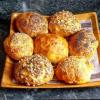January 30, 2020 - 3:06pm

Forkish: White Bread with Poolish with a slight sourdough twist.

I made one bread according to Forkish's recipe (half the amount of flour, water, etc. that is listed in the book).
In the morning the polish had not developed that well partly due to the kitchen being a bit colder overnight. I had some sourdough starter left that I had used to rebuild my starter. So I added 70g of this active starter (rye, 100@ hydration) to the whole mix. I used an oblong cloches for baking. I'm very happy with the result. The darker rye did not mix completely with the rest of the dough and one can still see some guy streaks in the bread. The taste is very mild.



Comments
super nice. How did you get the crumb to develop the way it did. Did you apply the pincer method or something more advanced. I made forkish's white loaf with poolish yesterday. I used the rubaud method to knead.
The bread looks great! Have you tried adding sourdough starter to a yeasted poolish before with success? I've always read that commericial yeast will quickly overwhelm a sourdough starter and they should not be mixed. I should add that I haven't used Forkish before so I'm not sure how it has you starting a poolish. I always use a scant 1/8th tsp to 500g flour/500g water with a 12-14 hour development period. I also substitute 10% whole wheat with 90% AP; even when the recipe calls for 100% AP. That little bit of extra fuel seems to make a difference.
I can see the benefit of a starter being added if the poolish hasn't developed enough; especially if I'm on a schedule.
Cheers
PG4: You're correct that it is generally recommended against to add commercial yeast to the starter that you keep as an ongoing culture.
But, in assembling the dough that you are going to bake, it is common to see some formulas that use both sourdough starter and commercial yeast.
The goals may be quicker rise, quicker rise + less acid. Or because your starter is weak or old, or you don't have enough, and you don't have time to feed and build up your starter/levain.
Sometimes, when I start the process, I realize that I didn't plan ahead well enough, and I realize using only the little or un-refreshed sourdough starter I have is not going to fit my schedule, so I "cheat" and either add instant dry yeast, or some dried malt extract to kickstart/turbo-boost what little or old starter I do have.
I've seen it in several of my bread books, but one of Reinhart's is the only one that comes to mind, without me going to look.